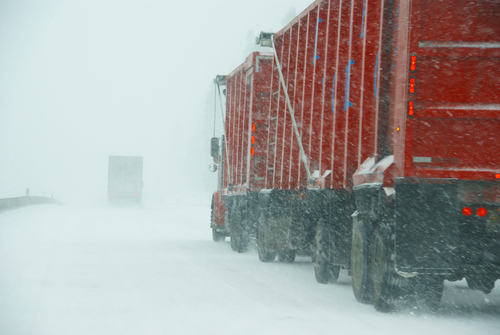You may have seen “Ice Road Truckers” on the History Channel. If not, it might be worth your time to watch an episode. I’m not a regular viewer, but for me the show is an occasional guilty pleasure. And now it’s in its seventh season, so I’m not the only one who’s watching.
It’s also a look at basic risk management in some of the toughest conditions on the planet—semis traveling on seasonal routes in remote areas of Alaska and Canada. This season follows drivers for the Polar Bear trucking company located in Manitoba, Canada. Seven truckers, often making their trips alone, drive fully loaded semis over frozen lakes, battling the elements to deliver building supplies, heavy equipment, gravel—you name it. Conditions are desolate and often 55 degrees below zero.
To take it even further, Polar Bear and a rival company—owned by a former, and bitter, Polar Bear employee—are competing for delivery assignments. Not completing an assignment means no pay for the drivers, more work for the competition and also that a village somewhere doesn’t get a delivery of badly needed supplies.
I know from personal experience that when it gets down to the 20s and teens here in New York, all kinds of things can happen to heavy equipment. With my commuter train, for instance, engines need to be kept running all night to make sure the trains are operational on cold, icy mornings; and signaling equipment can go on the blink, delaying trains and throwing off schedules. I can’t imagine what it must be like at 55 degrees below zero!
The Polar Bear trucking company can only do so much for drivers who must maneuver icy roads over a frozen lake. The drivers themselves put their lives on the line to make their deliveries. As more and more trucks traverse the roads, the ice highways become pitted. Friction from trucks and temperature changes mean the ice also gets thinner—producing hair-raising episodes, where the ice is moving and trucks get stuck in giant pools of melt. Will they get the truck out? Or will it go right through the ice? Anyway, you get the idea.
Cast member Joey “The King of Obsolete” Barnes has a large collection of vintage CATs and trucks from the 1930s to 1970s. Many are unique pieces of equipment that he has reassembled from miscellaneous parts. In one episode, Joey uses one of his reconstructed trucks to help another driver pull a semi, hauling a flatbed of heavy equipment, out of a deep patch of melting ice. In the same episode, driver Art Burke discovers his truck is having fuel pump and/or fuel line problems. He never really figures out which, but to start the truck and keep it running, he has to manually feed fuel to the engine. Sure enough, the truck again doesn’t start—in the middle of a vast ice landscape—but Art somehow manages to get fuel to the engine and keep it going.
Since it’s impossible for me to watch a show like this without thinking about the risk management implications, I noted two distinct risk management styles. Joey keeps a lot of heavy equipment and spare parts and is ready for any emergency. To stay on schedule, Art heads out over the treacherous ice, knowing he is having engine trouble, but trusting his skills and experience to get him through. Not only do these drivers have to foresee and manage dangerous risks, but the camera and production crew are often traveling right alongside them. And so their safety and liability is an issue as well.
I’m sure that risk managers can relate to these disparate styles. Oddly, they both work, even in these extreme conditions, because both Joey and Art both know their jobs, the conditions and equipment so well. It’s risk management in its most raw form and there are lessons to be gleaned. But don’t take my word for it, see for yourself and be prepared for a nail-biter.

